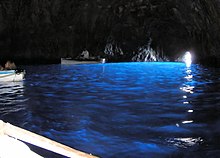Hans Christian Andersen (1805 - 1875), the Danish writer, most famous for his fairy tales, also wrote a number of books about his travels, and is associated with a number of places that present-day tourists can visit.
Denmark
[edit]Odense
[edit]The primary locations are museums about Andersen in Odense, the third-largest city of Denmark. The H.C. Andersens Hus (house of Hans Christian Andersen) at Hans Jensens Stræde 45 is his claimed place of birth.
- 1 Hans Christian Andersen Museum, Bangs Boder 29, ☏ +45 65 51 46 01. Daily 10:00-16:00 (or 18:00 in July-August). A museum dedicated to the city's most famous son, author and poet Hans Christian Andersen, most famous for his fairy tales and in particular The Ugly Duckling and the Little Mermaid. Part of the museum is located in the house where Andersen was supposedly born (though he would never confirm it). The impressive collection is mainly documents from his life and times, period furniture, and many drawings and paper clippings he is famous for at home. 55 kr for entrance.
- Munkemøllestræde H.C. Andersens barndomshjem, Munkemøllestræde 3.
- Bramstrup herregård
Copenhagen
[edit]Hans Christian Andersen lived for the most part of his life in Nyhavn, Copenhagen in three different locations: Number 20 (then number 280) from 1834 to 1838, number 67 from 1848 to 1865 and number 18 which he moved in in 1872. The red building as number 20 has a commemorative plaque visible from the street. It reads "H. C. Andersen / lived here / when his first / fairy tale booklet was published / May 1835".
Other parts of Zealand
[edit]
- Gisselfeld. Site where Andersen wrote The Ugly Duckling.
Andersen's travels
[edit]Reasons for travel
[edit]Travel provided Andersen (1805-1875) with a means to escape from loneliness. He undertook long trips to various European countries and his travel logs detail impressions collected over the course of his many journeys. In contrast, these observations are rarely reflected in his fairy tales. Only occasionally did Andersen set his tales in locations that he himself had visited, such as Germany, Spain, and Switzerland.
Travel to Italy and The Improvisatore
[edit]
Andersen's novel The Improvisatore (1835) is in part a travelogue about Italy and contains travel guide descriptions of Rome, Naples, Herculaneum, Sorrento, Paestum and Capri, as well as a minor part about Venice and Milan. The book made the Blue Grotto at Capri famous.
The background for the novel was a trip to Italy that Hans Christian Andersen made in 1833 and 1834. He got a travel stipend on March 13, 1833 and set off on March 22 the same year. He traveled via Lübeck, Hamburg, Celle, Hanover, Kassel and on to Frankfurt and Mainz.
The novel begins with:
- Whoever has been in Rome is well acquainted with the Piazza Barberina, in the great square, with the beautiful fountain, where the Tritons empty the spouting conchshell, from which the water springs upwards many feet.
Travel to Spain
[edit]Hans Christian Andersen arrived in Málaga, Spain on 30 September 1862 on a steamship from Gibraltar. He stayed at the Hotel del Oriente del Fonda. He travelled to Granada to see the Alhambra and returned to Málaga on 22 October 1862. He left on 29 October 1862 for Cartagena. There is a statue of Andersen in the Plaza de la Marina in Málaga, put up to commemorate the 200th anniversary of his birth.
Travel to Africa
[edit]On November 2, 1862 at the end of an extended trip to Spain, Andersen boarded a steam ship from Gibraltar to North Africa. He stayed in the Moroccan port city of Tangier for a week. Full of curiosity, he spent his days observing camel caravans, orange gardens, and porcupines ("upon my return, I found one of its large quills, which now serves me as a fountain pen"), and resided with the Danish Consul.
[Quotations from "Hans Christian Andersen: In Spanien. Hamburg: Rotbuch Verlag 1998" (according to the 1863 edition, revised and abridged by Anne Glienke)].
Andersen’s travel writing
[edit]In 1840-41, Andersen travelled to Italy, Greece and Constantinople, a journey described in “A Poet's Bazaar: Pictures of Travel in Germany, Italy, Greece, and the Orient” (1842).
In 1847, Andersen visited England and met author Charles Dickens. “A Christmas Greeting to my English Friends” (containing five fairy tales) was published (CreateSpace Independent Publishing Platform, 2018; ISBN 1983475939, ISBN 9781983475931).
“Pictures of Travel in Sweden, Among the Hartz Mountains, and in Switzerland, with a Visit at Charles Dicken's House.” The Danish original, I Sverrig, was published in 1851. It was translated to English and published in 1851 in London.
“A Visit To Spain and North Africa, 1862” is a travel book by Hans Christian Andersen (Publisher Owen, 1975; Original from the University of Michigan; Digitized Jul 9, 2008; ISBN 0720603234, ISBN 9780720603231).

